 |
| FIG. 888– Sagittal section of right orbital cavity. |
|
(Organa Oculi Accessoria) The accessory organs of the eye include the ocular muscles, the fasciæ, the eyebrows, the eyelids, the conjunctiva, and the lacrimal apparatus. |
| |
| The Ocular Muscles (musculi oculi).—The ocular muscles are the: |
| Levator palpebræ superioris | | Rectus medialis. |
| Rectus superior. | | Rectus lateralis. |
| Rectus inferior. | | Obliquus superior. |
| Obliquus inferior. | |
| |
| The Levator palpebræ superioris (Fig. 888) is thin, flat, and triangular in shape. It arises from the under surface of the small wing of the sphenoid, above and in front of the optic foramen, from which it is separated by the origin of the Rectus superior. At its origin, it is narrow and tendinous, but soon becomes broad and fleshy, and ends anteriorly in a wide aponeurosis which splits into three lamellæ. The superficial lamella blends with the upper part of the orbital septum, and is prolonged forward above the superior tarsus to the palpebral part of the Orbicularis oculi, and to the deep surface of the skin of the upper eyelid. The middle lamella, largely made up of non-striped muscular fibers, is inserted into the upper margin of the superior tarsus, while the deepest lamella blends with an expansion from the sheath of the Rectus superior and with it is attached to the superior fornix of the conjunctiva. |
| Whitnall (*148 has pointed out that the upper part of the sheath of the Levator palpebræ becomes thickened in front and forms, above the anterior part of the muscle, a transverse ligamentous band which is attached to the sides of the orbital cavity. On the medial side it is mainly fixed to the pulley of the Obliquus superior, but some fibers are attached to the bone behind the pulley and a slip passes forward and bridges over the supraorbital notch; on the lateral side it is fixed to the capsule of the lacrimal gland and to the frontal bone. In front of the transverse ligamentous band the sheath is continued over the aponeurosis of the Levator palpebræ, as a thin connective-tissue layer which is fixed to the upper orbital margin immediatly behind the attachment of the orbital septum. When the Levator palpebræ contracts, the lateral and medial parts of the ligamentous band are stretched and check the action of the muscle; the retraction of the upper eyelid is checked also by the orbital septum coming into contact with the transverse part of the ligamentous band. |
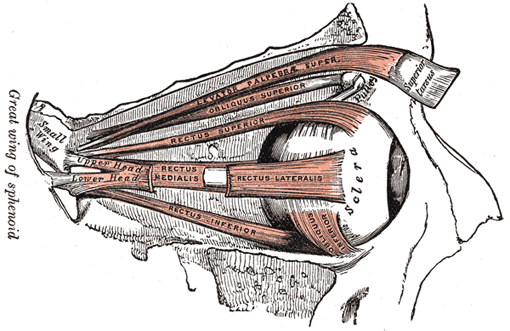 |
| FIG. 889– Muscles of the right orbit. |
| |
| The four Recti (Fig. 889) arise from a fibrous ring (annulus tendineus communis) which surrounds the upper, medial, and lower margins of the optic foramen and encircles the optic nerve (Fig. 890). The ring is completed by a tendinous bridge prolonged over the lower and medial part of the superior orbital fissure and attached to a tubercle on the margin of the great wing of the sphenoid, bounding the fissure. Two specialized parts of this fibrous ring may be made out: a lower, the ligament or tendon of Zinn, which gives origin to the Rectus inferior, part of the Rectus internus, and the lower head of origin of the Rectus lateralis; and an upper, which gives origin to the Rectus superior, the rest of the Rectus medialis, and the upper head of the Rectus lateralis. This upper band is sometimes termed the superior tendon of Lockwood. Each muscle passes forward in the position implied by its name, to be inserted by a tendinous expansion into the sclera, about 6 mm. from the margin of the cornea. Between the two heads of the Rectus lateralis is a narrow interval, through which pass the two divisions of the oculomotor nerve, the nasociliary nerve, the abducent nerve, and the ophthalmic vein. Although these muscles present a common origin and are inserted in a similar manner into the sclera, there are certain differences to be observed in them as regards their length and breadth. The Rectus medialis is the broadest, the Rectus lateralis the longest, and the Rectus superior the thinnest and narrowest. |
| The Obliquus oculi superior (superior oblique) is a fusiform muscle, placed at the upper and medial side of the orbit. It arises immediately above the margin of the optic foramen, above and medial to the origin of the Rectus superior, and, passing forward, ends in a rounded tendon, which plays in a fibrocartilaginous ring or pulley attached to the trochlear fovea of the frontal bone. The contiguous surfaces of the tendon and ring are lined by a delicate mucous sheath, and enclosed in a thin fibrous investment. The tendon is reflected backward, lateralward, and downward beneath the Rectus superior to the lateral part of the bulb of the eye, and is inserted into the sclera, behind the equator of the eyeball, the insertion of the muscle lying between the Rectus superior and Rectus lateralis. |
| The Obliquus oculi inferior (inferior oblique) is a thin, narrow muscle, placed near the anterior margin of the floor of the orbit. It arises from the orbital surface of the maxilla, lateral to the lacrimal groove. Passing lateralward, backward, and upward, at first between the Rectus inferior and the floor of the orbit, and then between the bulb of the eye and the Rectus lateralis, it is inserted into the lateral part of the sclera between the Rectus superior and Rectus lateralis, near to, but somewhat behind the insertion of the Obliquus superior. |
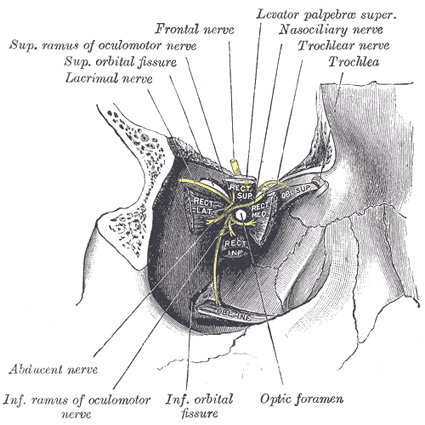 |
| FIG. 890– Dissection showing origins of right ocular muscles, and nerves entering by the superior orbital fissure. |
| |
| |
| Nerves.—The Levator palpebræ superioris, Obliquus inferior, and the Recti superior, inferior, and medialis are supplied by the oculomotor nerve; the Obliquus superior, by the trochlear nerve; the Rectus lateralis, by the abducent nerve. |
| |
| Actions.—The Levator palpebræ raises the upper eyelid, and is the direct antagonist of the Orbicularis oculi. The four Recti are attached to the bulb of the eye in such a manner that, acting singly, they will turn its corneal surface either upward, downward, medialward, or lateralward, as expressed by their names. The movement produced by the Rectus superior or Rectus inferior is not quite a simple one, for inasmuch as each passes obliquely lateralward and forward to the bulb of the eye, the elevation or depression of the cornea is accompanied by a certain deviation medialward, with a slight amount of rotation. These latter movements are corrected by the Obliqui, the Obliquus inferior correcting the medial deviation caused by the Rectus superior and the Obliquus superior that caused by the Rectus inferior. The contraction of the Rectus lateralis or Rectus medialis, on the other hand, produces a purely horizontal movement. If any two neighboring Recti of one eye act together they carry the globe of the eye in the diagonal of these directions, viz., upward and medialward, upward and lateralward, downward and medialward, or downward and lateralward. Sometimes the corresponding Recti of the two eyes act in unison, and at other times the opposite Recti act together. Thus, in turning the eyes to the right, the Rectus lateralis of the right eye will act in unison with the Rectus medialis of the left eye; but if both eyes are directed to an object in the middle line at a short distance, the two Recti mediales will act in unison. The movement of circumduction, as in looking around a room, is performed by the successive actions of the four Recti. The Obliqui rotate the eyeball on its antero-posterior axis, the superior directing the cornea downward and lateralward, and the inferior directing it upward and lateralward; these movements are required for the correct viewing of an object when the head is moved laterally, as from shoulder to shoulder, in order that the picture may fall in all respects on the same part of the retina of either eye. |
| A layer of non-striped muscle, the Orbitalis muscle of H. Müller, may be seen bridging across the inferior orbital fissure. |
 |
| FIG. 891– The right eye in sagittal section, showing the fascia bulbi (semidiagrammatic). (Testut.) |
| |
| The Fascia Bulb (capsule of Ténon) (Fig. 891) is a thin membrane which envelops the bulb of the eye from the optic nerve to the ciliary region, separating it from the orbital fat and forming a socket in which it plays. Its inner surface is smooth, and is separated from the outer surface of the sclera by the periscleral lymph space. This lymph space is continuous with the subdural and subarachnoid cavities, and is traversed by delicate bands of connective tissue which extend between the fascia and the sclera. The fascia is perforated behind by the ciliary vessels and nerves, and fuses with the sheath of the optic nerve and with the sclera around the entrance of the optic nerve. In front it blends with the ocular conjunctiva, and with it is attached to the ciliary region of the eyeball. It is perforated by the tendons of the ocular muscles, and is reflected backward on each as a tubular sheath. The sheath of the Obliquus superior is carried as far as the fibrous pulley of that muscle; that on the Obliquus inferior reaches as far as the floor of the orbit, to which it gives off a slip. The sheaths on the Recti are gradually lost in the perimysium, but they give off important expansions. The expansion from the Rectus superior blends with the tendon of the Levator palpebræ; that of the Rectus inferior is attached to the inferior tarsus. The expansions from the sheaths of the Recti lateralis and medialis are strong, especially that from the latter muscle, and are attached to the lacrimal and zygomatic bones respectively. As they probably check the actions of these two Recti they have been named the medial and lateral check ligaments. Lockwood has described a thickening of the lower part of the facia bulbi, which he has named the suspensory ligament of the eye. It is slung like a hammock below the eyeball, being expanded in the center, and narrow at its extremities which are attached to the zygomatic and lacrimal bones respectively. (*149 |
| The Orbital Fascia forms the periosteum of the orbit. It is loosely connected to the bones and can be readily separated from them. Behind, it is united with the dura mater by processes which pass through the optic foramen and superior orbital fissure, and with the sheath of the optic nerve. In front, it is connected with the periosteum at the margin of the orbit, and sends off a process which assists in forming the orbital septum. From it two processes are given off; one to enclose the lacrimal gland, the other to hold the pulley of the Obliquus superior in position. |
| The Eyebrows (supercilia) are two arched eminences of integument, which surmount the upper circumference of the orbits, and support numerous short, thick hairs, directed obliquely on the surface. The eyebrows consist of thickened integument, connected beneath with the Orbicularis oculi, Corrugator, and Frontalis muscles. |
| The Eyelids (palpebræ) are two thin, movable folds, placed in front of the eye, protecting it from injury by their closure. The upper eyelid is the larger, and the more movable of the two, and is furnished with an elevator muscle, the Levator palpebræ superioris. When the eyelids are open, an elliptical space, the palpebral fissure (rima palpebrarum), is left between their margins, the angles of which correspond to the junctions of the upper and lower eyelids, and are called the palpebral commissures or canthi. |
| The lateral palpebral commissure (commissura palpebrarum lateralis; external canthus) is more acute than the medial, and the eyelids here lie in close contact with the bulb of the eye: but the medial palpebral commissure (commissura palpebrarum medialis; internal canthus) is prolonged for a short distance toward the nose, and the two eyelids are separated by a triangular space, the lacus lacrimalis (Fig. 892). At the basal angles of the lacus lacrimalis, on the margin of each eyelid, is a small conical elevation, the lacrimal papilla, the apex of which is pierced by a small orifice, the punctum lacrimale, the commencement of the lacrimal duct. |
| The eyelashes (cilia) are attached to the free edges of the eyelids; they are short, thick, curved hairs, arranged in a double or triple row: those of the upper eyelid, more numerous and longer than those of the lower, curve upward; those of the lower eyelid curve downward, so that they do not interlace in closing the lids. Near the attachment of the eyelashes are the openings of a number of glands, the ciliary glands, arranged in several rows close to the free margin of the lid; they are regarded as enlarged and modified sudoriferous glands. |
| |
| Structure of the Eyelids.—The eyelids are composed of the following structures taken in their order from without inward: integument, areolar tissue, fibers of the Orbicularis oculi, tarsus, orbital septum, tarsal glands and conjunctiva. The upper eyelid has, in addition, the aponeurosis of the Levator palpebræ superioris (Fig. 893). |
| The integument is extremely thin, and continuous at the margins of the eyelids with the conjunctiva. |
| The subcutaneous areolar tissue is very lax and delicate, and seldom contains any fat. |
| The palpebral fibers of the Orbicularis oculi are thin, pale in color, and possess an involuntary action. |
| The tarsi (tarsal plates) (Fig. 894) are two thin, elongated plates of dense connective tissue, about 2.5 cm. in length; one is placed in each eyelid, and contributes to its form and support. The superior tarsus (tarsus superior; superior tarsal plate), the larger, is of a semilunar form, about 10 mm. in breadth at the center, and gradually narrowing toward its extremities. To the anterior surface of this plate the aponeurosis of the Levator palpebræ superioris is attached. The inferior tarsus (tarsus inferior; inferior tarsal plate), the smaller, is thin, elliptical in form, and has a vertical diameter of about 5 mm. The free or ciliary margins of these plates are thick and straight. The attached or orbital margins are connected to the circumference of the orbit by the orbital septum. The lateral angles are attached to the zygomatic bone by the lateral palpebral raphé. The medial angles of the two plates end at the lacus lacrimalis, and are attached to the frontal process of the maxilla by the medial palpebral ligament (page 381). |
| The orbital septum (septum orbitale; palpebral ligament) is a membranous sheet, attached to the edge of the orbit, where it is continuous with the periosteum. In the upper eyelid it blends by its peripheral circumference with the tendon of the Levator palpebræ superioris and the superior tarsus, in the lower eyelid with the inferior tarsus. Medially it is thin, and, becoming separated from the medial palpebral ligament, is fixed to the lacrimal bone immediately behind the lacrimal sac. The septum is perforated by the vessels and nerves which pass from the orbital cavity to the face and scalp. The eyelids are richly supplied with blood. |
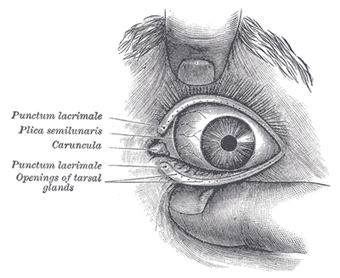 |
| FIG. 892– Front of left eye with eyelids separated to show medial canthus. |
| |
| |
| The Tarsal Glands (glandulæ tarsales [Meibomi]; Meibomian glands) (Fig. 895).—The tarsal glands are situated upon the inner surfaces of the eyelids, between the tarsi and conjunctiva, and may be distinctly seen through the latter on everting the eyelids, presenting an appearance like parallel strings of pearls. There are about thirty in the upper eyelid, and somewhat fewer in the lower. They are imbedded in grooves in the inner surfaces of the tarsi, and correspond in length with the breadth of these plates; they are, consequently, longer in the upper than in the lower eyelid. Their ducts open on the free magins of the lids by minute foramina. |
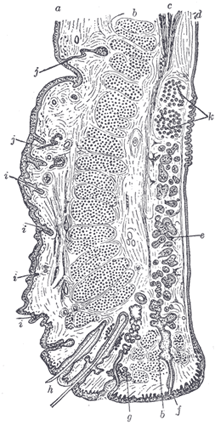 |
| FIG. 893– Sagittal section through the upper eyelid. (After Waldeyer.) a. Skin. b. Orbicularis oculi. b’. Marginal fasciculus of Orbicularis (ciliary bundle). c. Levator palpebræ. d. Conjunctiva. e. Tarsus. f. Tarsal gland. g. Sebaceous gland. h. Eyelashes. i. Small hairs of skin. Sweat glands. k. Posterior tarsal glands. |
| |
| |
| Structure.—The tarsal glands are modified sebaceous glands, each consisting of a single straight tube or follicle, with numerous small lateral diverticula. The tubes are supported by a basement membrane, and are lined at their mouths by stratified epithelium; the deeper parts of the tubes and the lateral offshoots are lined by a layer of polyhedral cells. |
| The conjunctiva is the mucous membrane of the eye. It lines the inner surfaces of the eyelids or palpebræ, and is reflected over the forepart of the sclera and cornea. |
| The Palpebral Portion (tunica conjunctiva palpebrarum) is thick, opaque, highly vascular, and covered with numerous papillæ, its deeper part presenting a considerable amount of lymphoid tissue. At the margins of the lids it becomes continuous with the lining membrane of the ducts of the tarsal glands, and, through the lacrimal ducts, with the lining membrane of the lacrimal sac and nasolacrimal duct. At the lateral angle of the upper eyelid the ducts of the lacrimal gland open on its free surface; and at the medial angle it forms a semilunar fold, the plica semilunaris. The line of reflection of the conjunctiva from the upper eyelid on to the bulb of the eye is named the superior fornix, and that from the lower lid the inferior fornix. |
 |
| FIG. 894– The tarsi and their ligaments. Right eye; front view. |
| |
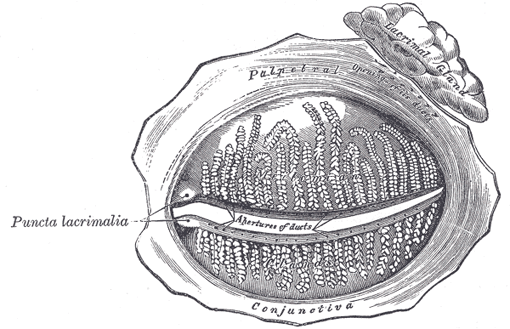 |
| FIG. 895– The tarsal glands, etc., seen from the inner surface of the eyelids. |
| |
| The Bulbar Portion (tunica conjunctiva bulbi).—Upon the sclera the conjunctiva is loosely connected to the bulb of the eye; it is thin, transparent, destitute of papillæ, and only slightly vascular. Upon the cornea, the conjunctiva consists only of epithelium, constituting the epithelium of the cornea, already described (see page 1007). Lymphatics arise in the conjunctiva in a delicate zone around the cornea, and run to the ocular conjunctiva. |
| In and near the fornices, but more plentiful in the upper than in the lower eyelid, a number of convoluted tubular glands open on the surface of the conjunctiva. Other glands, analogous to lymphoid follicles, and called by Henle trachoma glands, are found in the conjunctiva, and, according to Strohmeyer, are chiefly situated near the medial palpebral commissure. They were first described by Brush, in his description of Peyer’s patches of the small intestine, as “identical structures existing in the under eyelid of the ox.” |
| The caruncula lacrimalis is a small, reddish, conical-shaped body, situated at the medial palpebral commissure, and filling up the lacus lacrimalis. It consists of a small island of skin containing sebaceous and sudoriferous glands, and is the source of the whitish secretion which constantly collects in this region. A few slender hairs are attached to its surface. Lateral to the caruncula is a slight semilunar fold of conjunctiva, the concavity of which is directed toward the cornea; it is called the plica semilunaris. Müller found smooth muscular fibers in this fold; in some of the domesticated animals it contains a thin plate of cartilage. |
| The nerves in the conjunctiva are numerous and form rich plexuses. According to Krause they terminate in a peculiar form of tactile corpuscle, which he terms “terminal bulb.” |
| The Lacrimal Apparatus (apparatus lacrimalis) (Fig. 896) consists of (a) the lacrimal gland, which secretes the tears, and its excretory ducts, which convey the fluid to the surface of the eye; (b) the lacrimal ducts, the lacrimal sac, and the nasolacrimal duct, by which the fluid is conveyed into the cavity of the nose. |
| |
| The Lacrimal Gland (glandula lacrimalis).—The lacrimal gland is lodged in the lacrimal fossa, on the medial side of the zygomatic process of the frontal bone. It is of an oval form, about the size and shape of an almond, and consists of two portions, described as the superior and inferior lacrimal glands. The superior lacrimal gland is connected to the periosteum of the orbit by a few fibrous bands, and rests upon the tendons of the Recti superioris and lateralis, which separate it from the bulb of the eye. The inferior lacrimal gland is separated from the superior by a fibrous septum, and projects into the back part of the upper eyelid, where its deep surface is related to the conjunctiva. The ducts of the glands, from six to twelve in number, run obliquely beneath the conjunctiva for a short distance, and open along the upper and lateral half of the superior conjunctival fornix. |
| |
| Structures of the Lacrimal Gland (Fig. 897).—In structure and general appearance the lacrimal resembles the serous salivary glands (p. 1136). In the recent state the cells are so crowded with granules that their limits can hardly be defined. They contain oval nuclei, and the cell protoplasm is finely fibrillated. |
| |
| The Lacrimal Ducts (ductus lacrimalis; lacrimal canals).—The lacrimal ducts, one in each eyelid, commence at minute orifices, termed puncta lacrimalia, on the summits of the papillæ lacrimales, seen on the margins of the lids at the lateral extremity of the lacus lacrimalis. The superior duct, the smaller and shorter of the two, at first ascends, and then bends at an acute angle, and passes medialward and downward to the lacrimal sac. The inferior duct at first descends, and then runs almost horizontally to the lacrimal sac. At the angles they are dilated into ampullæ; their walls are dense in structure and their mucous lining is covered by stratified squamous epithelium, placed on a basement membrane. Outside the latter is a layer of striped muscle, continuous with the lacrimal part of the Orbicularis oculi; at the base of each lacrimal papilla the muscular fibers are circularly arranged and form a kind of sphincter. |
| |
| The Lacrimal Sac (saccus lacrimalis).—The lacrimal sac is the upper dilated end of the nasolacrimal duct, and is lodged in a deep groove formed by the lacrimal bone and frontal process of the maxilla. It is oval in form and measures from 12 to 15 mm. in length; its upper end is closed and rounded; its lower is continued into the nasolacrimal duct. Its superficial surface is covered by a fibrous expansion derived from the medial palpebral ligament, and its deep surface is crossed by the lacrimal part of the Orbicularis oculi (page 380), which is attached to the crest on the lacrimal bone. |
| |
| Structure.—The lacrimal sac consists of a fibrous elastic coat, lined internally by mucous membrane: the latter is continuous, through the lacrimal ducts, with the conjunctiva, and through the nasolacrimal duct with the mucous membrane of the nasal cavity. |
| The Nasolacrimal Duct (ductus nasolacrimalis; nasal duct).—The nasolacrimal duct is a membranous canal, about 18 mm. in length, which extends from the lower part of the lacrimal sac to the inferior meatus of the nose, where it ends by a somewhat expanded orifice, provided with an imperfect valve, the plica lacrimalis (Hasneri), formed by a fold of the mucous membrane. It is contained in an osseous canal, formed by the maxilla, the lacrimal bone, and the inferior nasal concha; it is narrower in the middle than at either end, and is directed downward, backward, and a little lateralward. The mucous lining of the lacrimal sac and nasolacrimal duct is covered with columnar epithelium, which in places is ciliated. |
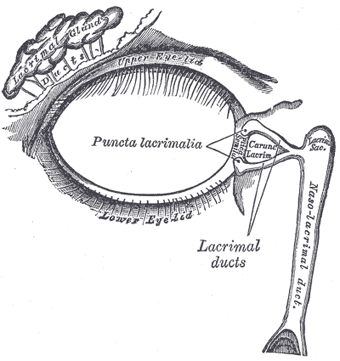 |
| FIG. 896– The lacrimal apparatus. Right side. |
| |
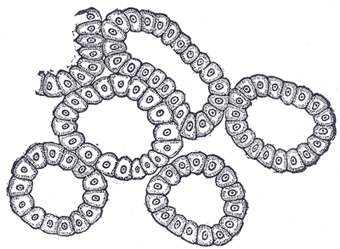 |
| FIG. 897– Alveoli of lacrimal gland. |
| |










